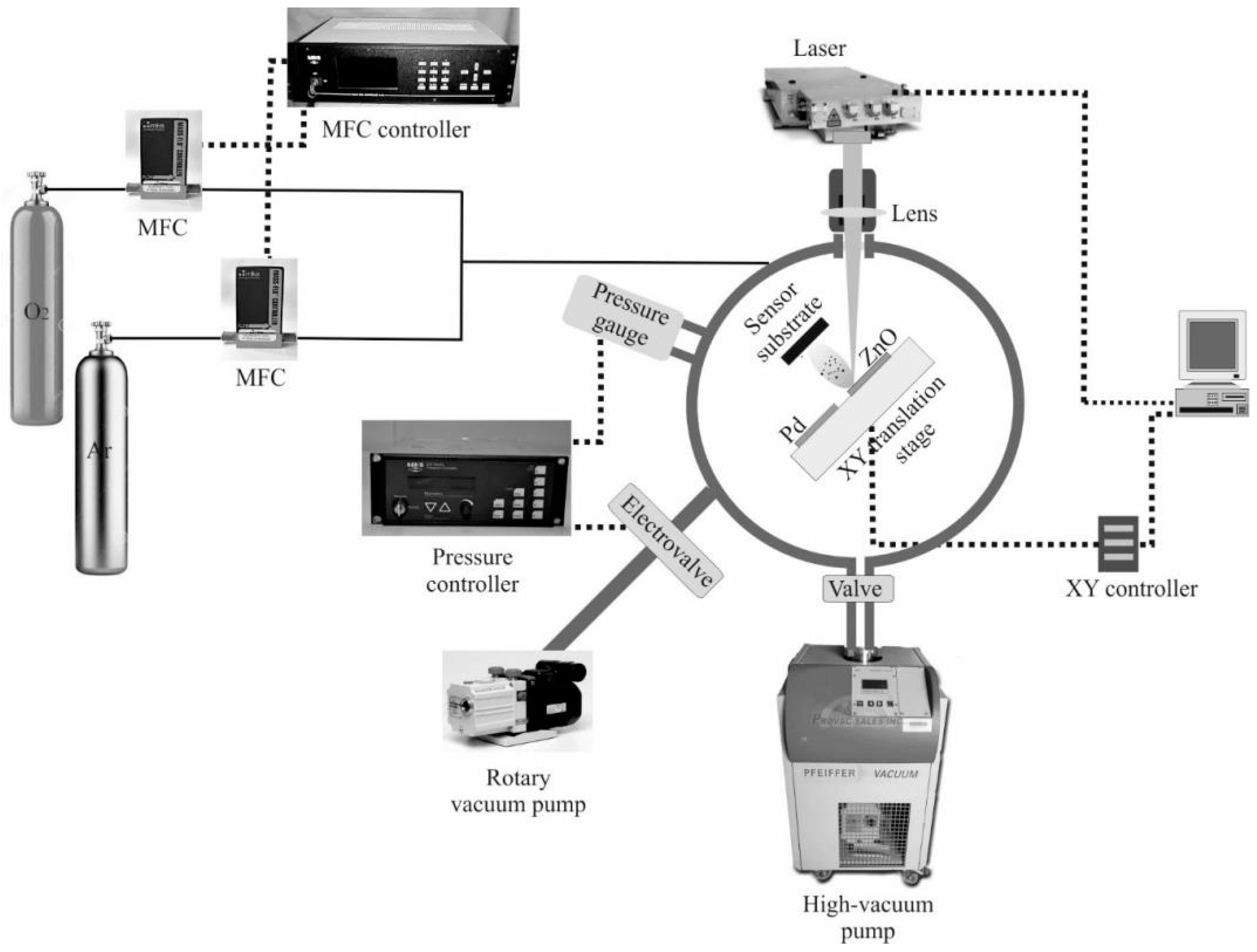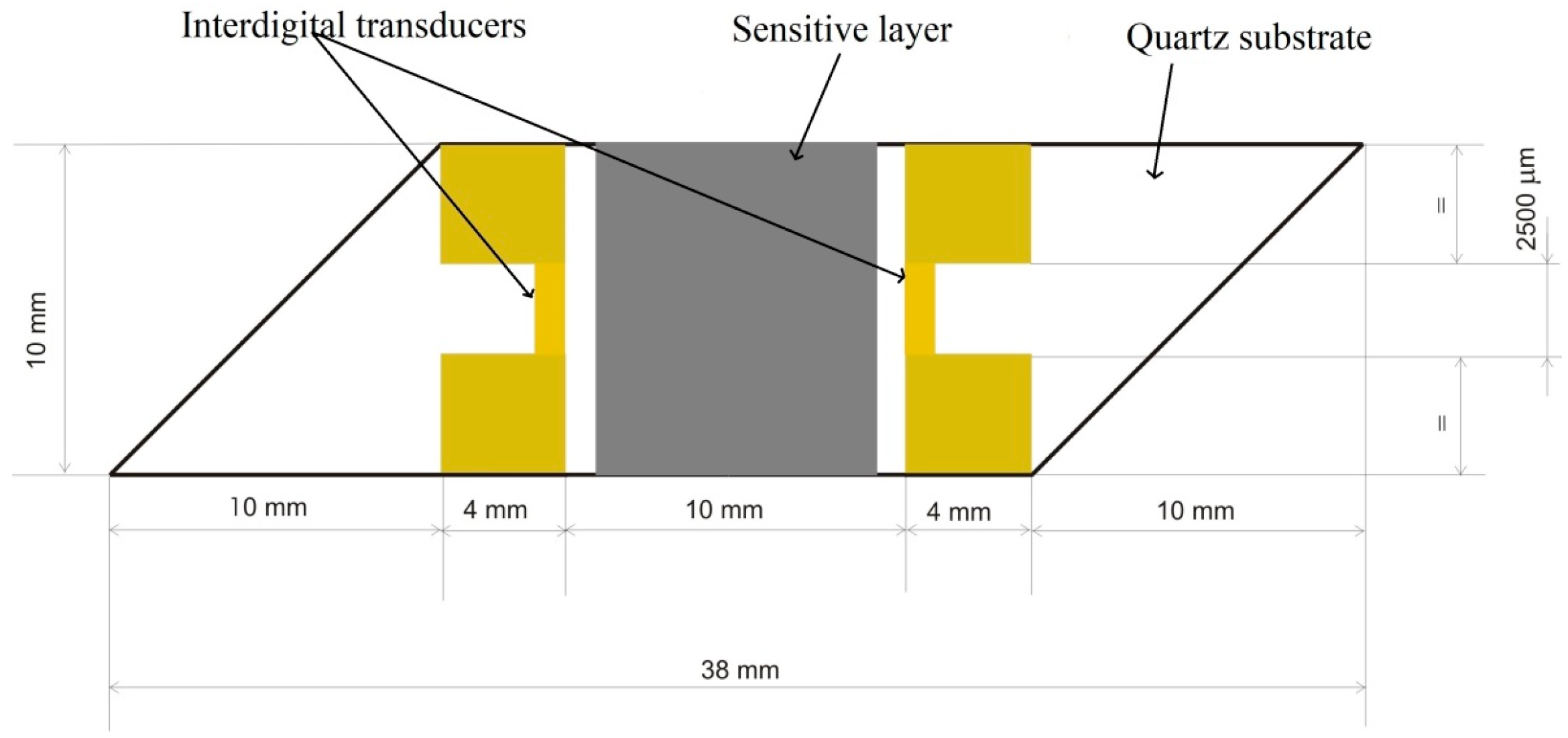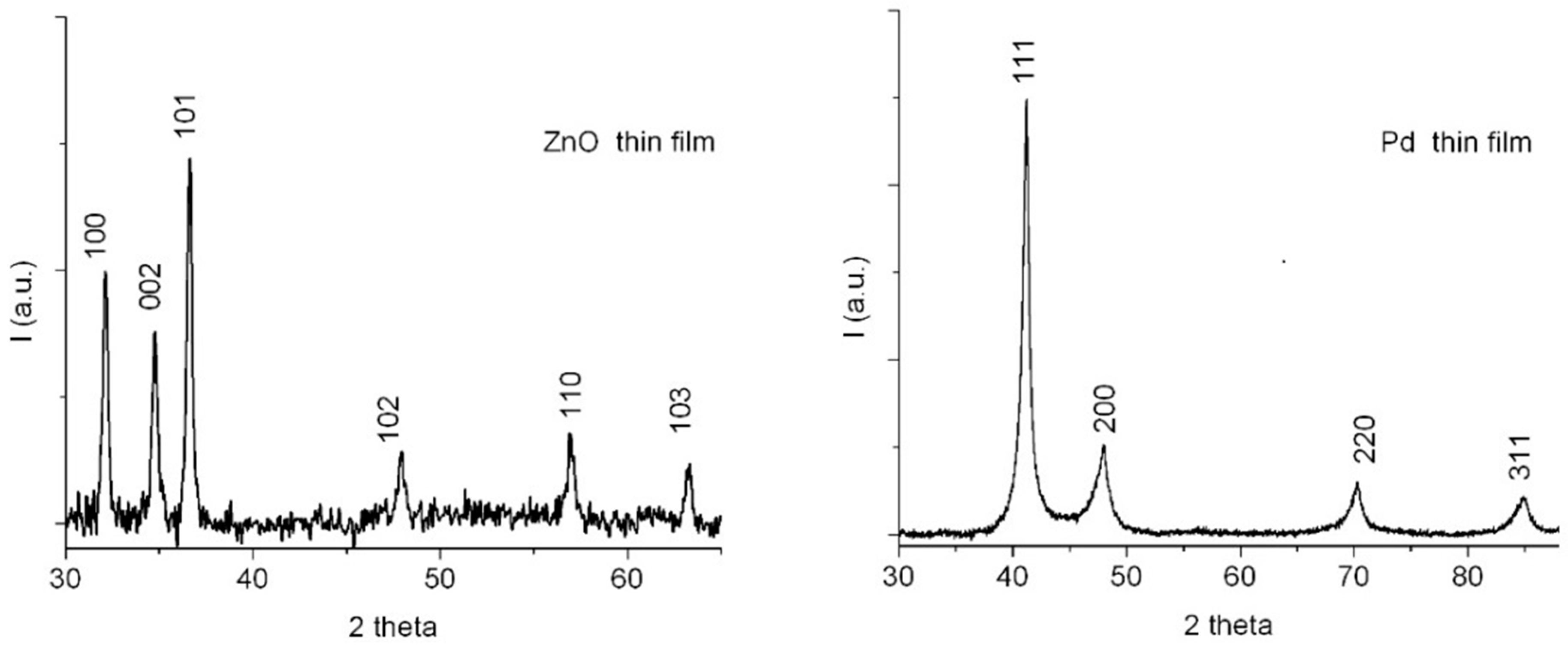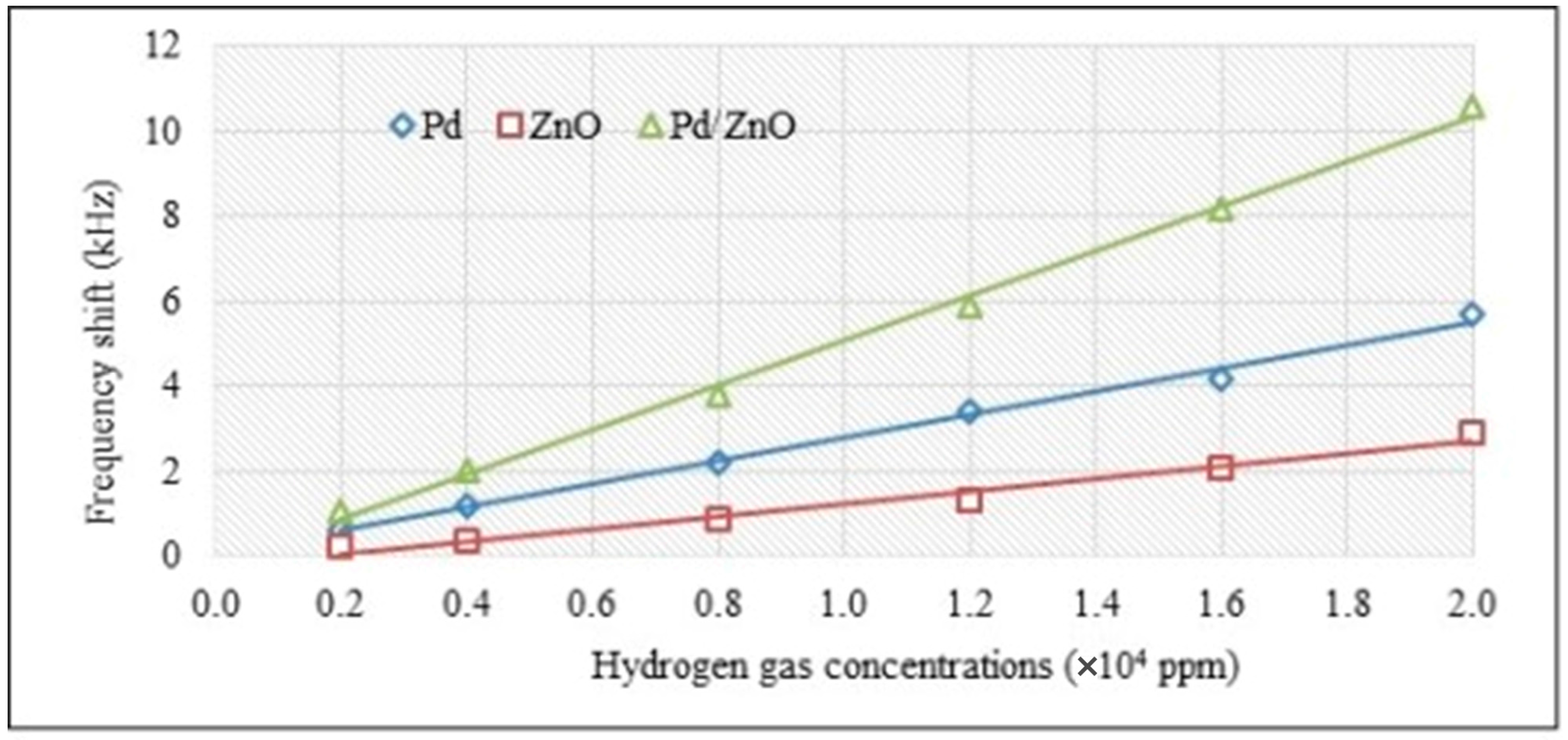Surface Acoustic Wave Sensor with Pd/ZnO Bilayer Structure for Room Temperature Hydrogen Detection
Abstract
:1. Introduction
2. Materials and Methods
2.1. Film Deposition and Characterization
2.2. Sensor Structure and Testing
3. Results
3.1. Film Morphology and Structure
3.2. Sensor Properties
4. Discussion and Conclusions
Acknowledgments
Author Contributions
Conflicts of Interest
References
- Jacobson, M.Z.; Colella, W.G.; Golden, D.M. Clearing the Air and Improving Health with Hydrogen Fuel-Cell Vehicles. Science 2005, 308, 1901–1905. [Google Scholar] [CrossRef] [PubMed]
- Bassam, A.M.; Phillips, A.B.; Turnock, S.R.; Wilson, P.A. Development of a multi-scheme energy management strategy for a hybrid fuel cell driven passenger ship. Int. J. Hydrog. Energy 2017, 42, 623–635. [Google Scholar] [CrossRef]
- Grimes, C.A.; Ong, K.G.; Varghese, O.K.; Yang, X.; Mor, G.; Paulose, M.; Dickey, E.C.; Ruan, C.; Pishko, M.V.; Kendig, J.W.; et al. A Sentinel Sensor Network for Hydrogen Sensing. Sensors 2003, 3, 69–82. [Google Scholar] [CrossRef]
- Boon-Brett, L.; Bousk, J.; Black, G.; Moretto, P.; Castello, P.; Hübert, T.; Banach, U. Identifying performance gaps in hydrogen safety sensor technology for automotive and stationary applications. Int. J. Hydrog. Energy 2010, 35, 373–384. [Google Scholar] [CrossRef]
- Buttner, W.J.; Post, M.B.; Burgess, R.; Rivkin, C. An overview of hydrogen safety sensors and requirements. Int. J. Hydrog. Energy 2011, 36, 2462–2470. [Google Scholar] [CrossRef]
- Hubert, T.; Boon-Brett, L.; Black, G.; Banach, U. Hydrogen sensors—A review. Sens. Actuators B Chem. 2011, 157, 329–352. [Google Scholar] [CrossRef]
- Cole, M.; Spulber, I.; Gardner, J. Surface acoustic wave electronic tongue for robust analysis of sensory components. Sens. Actuators B Chem. 2015, 207, 1147–1153. [Google Scholar] [CrossRef]
- Bhasker, R.V.; Nimal, A.T.; Parmar, Y.; Sharma, M.U.; Sreenivas, K.; Gupta, V. Cross sensitivity and selectivity studies on ZnO surface acoustic wave ammonia sensor. Sens. Actuators B Chem. 2010, 147, 517–524. [Google Scholar]
- Jakubik, W. Hydrogen gas-sensing with bilayer structures of WO3 and Pd in SAW and electric systems. Thin Solid Film 2009, 517, 6188–6191. [Google Scholar] [CrossRef]
- Ippolito, S.J.; Kandasamy, S.; Kalentar-Zadeh, K.; Wlodarski, W. Layered SAW hydrogen sensor with modified tungsten trioxide selective layer. Sens. Actuators B Chem. 2005, 108, 553–557. [Google Scholar] [CrossRef]
- Yang, L.; Yin, C.; Zhang, Z.; Zhou, J.; Xu, H. The investigation of hydrogen gas sensing properties of SAW gas sensor based on palladium surface modified SnO2 thin film. Mater. Sci. Semicond. Process. 2017, 60, 16–28. [Google Scholar] [CrossRef]
- Jakubik, W.; Urbanczyk, M.; Kochowski, S.; Bodzenta, J. Palladium and phthalocynine bilayer films for hydrogen detection in a surface acoustic wave sensor system. Sens. Actuators B Chem. 2003, 96, 321–328. [Google Scholar] [CrossRef]
- Jakubik, W. Elementary theory of SAW gas sensor based on electrical conductivity changes in bi-layer nanostructures. Sens. Actuators B Chem. 2014, 203, 511–516. [Google Scholar] [CrossRef]
- Jakubik, W.; Krzywiecki, M.; Maciak, E.; Urbańczyk, M. Bi-layer nanostructures of CuPc and Pd for resistance-type and SAW-type hydrogen gas sensors. Sens. Actuators B Chem. 2012, 175, 255–262. [Google Scholar] [CrossRef]
- Jakubik, W.; Powroznik, P.; Wrotniak, J.; Krzywiecki, M. Theoretical analysis of acoustoelectrical sensitivity in SAW gas sensors with single and bi-layer structures. Sens. Actuators B Chem. 2016, 236, 1069–1074. [Google Scholar] [CrossRef]
- Li, R.; Reyes, P.I.; Ragavendiran, S.; Shen, H.; Lu, Y. Tunable surface acoustic wave device based on acoustoelectric interaction in ZnO/GaN heterostructures. Appl. Phys. Lett. 2015, 107, 073504. [Google Scholar] [CrossRef]
- Dutheil, P.J.; Orlianges, C.; Crunteanu, A.; Catherinot, A.; Champeaux, C. AlN, ZnO thin films and AlN/ZnO or ZnO/AlN mulatilayer structures deposited by PLD for surface acoustic wave applications. Phys. Status Solidi A 2015, 212, 817–825. [Google Scholar] [CrossRef]
- Wang, S.Y.; Ma, J.Y.; Li, Z.J.; Su, H.Q.; Alkurd, N.R.; Zhou, W.L.; Wang, L.; Du, B.; Tang, Y.L.; Ao, D.Y.; et al. Surface acoustic wave ammonia sensor based on ZnO/SiO2 composite film. J. Hazard. Mater. 2015, 285, 368–374. [Google Scholar] [CrossRef] [PubMed]
- Noh, J.S.; Lee, J.M.; Lee, W. Low-dimensional Palladium nanostructures for fast and reliable Hydrogen gas detection. Sensors 2011, 11, 825–851. [Google Scholar] [CrossRef] [PubMed]
- Viespe, C.; Grigoriu, C. SAW sensor based on highly sensitive nanoporous palladium thin film for hydrogen detection. Microelectron. Eng. 2013, 108, 218–221. [Google Scholar] [CrossRef]
- Janotti, A.; Van de Walle, C.G. Fundamentals of zinc oxide as a semiconductor. Rep. Prog. Phys. 2009, 72, 126501. [Google Scholar] [CrossRef]
- Wu, T.T.; Wang, W.S. An experimental study on the ZnO/sapphire layered surface acoustic wave device. J. Appl. Phys. 2004, 96, 5249. [Google Scholar] [CrossRef]
- Schmidt, O.; Kiesel, P.; Van de Walle, C.G.; Johnson, N.M.; Nause, J.; Döhler, G.H. Effects of an electrically conducting layer on the zinc oxide surface. Jpn. J. Appl. Phys. 2005, 44, 7271–7274. [Google Scholar] [CrossRef]
- Schmidt, O.; Geis, A.; Kiesel, P.; Van de Walle, C.G.; Johnson, N.M.; Bakin, A.; Waag, A.; Döhler, G.H. Analysis of a conducting channel at the native zinc oxide surface. Superlattice. Microstruct. 2006, 39, 8–16. [Google Scholar] [CrossRef]
- Ballantine, D.S.; White, R.M.; Martin, S.I.; Ricco, A.J.; Zellers, E.T.; Frye, G.C.; Wohltjen, H. Acoustic Wave Sensors, Theory, Design and Physico-Chemical Applications; Academic Press: San Diego, CA, USA, 1997; pp. 337–339. [Google Scholar]
- Chrisey, D.B.; Hubler, G.K. Pulsed Laser Deposition of Thin Films; Wiley: New York, NY, USA, 1994. [Google Scholar]
- Marcu, A.; Viespe, C. Laser-grown ZnO Nanowires for Room-temperature SAW-sensor Applications. Sens. Actuators B Chem. 2015, 208, 1–6. [Google Scholar] [CrossRef]
- Viespe, C. Surface Acoustic Wave Sensors based on Nanoporous Films for Hydrogen Detection. Mater. Appl. Sens. Transducer. Key Eng. Mater. 2014, 605, 331–334. [Google Scholar] [CrossRef]
- Marcu, A.; Viespe, C. Active surface geometrical control of noise in nanowire-SAW sensors. Sens. Actuators B Chem. 2016, 231, 469–473. [Google Scholar] [CrossRef]
- Marcu, A.; Viespe, C. Surface Acoustic Wave Sensors for Hydrogen and Deuterium Detection. Sensors 2017, 17, 1417. [Google Scholar] [CrossRef] [PubMed]
- Campbell, C. Surface Acoustic Wave Devices and THEIR Signal Processing Applications; Academic Press: San Diego, CA, USA, 1989; p. 26. [Google Scholar]
- Di Fonzo, F.; Tonini, D.; Li Bessi, A.; Casari, C.S.; Beghi, M.G.; Bottani, C.E.; Gastaldi, D.; Vena, P.; Contro, R. Growth regimes in pulsed laser deposition of aluminum oxide thin films. Appl. Phys. A 2008, 93, 765–769. [Google Scholar] [CrossRef]
- Riabinina, D.; Irissou, E.; Le Drogoff, B.; Chaker, M.; Guay, D. Influence of pressure on the Pt nanoparticle growth modes during pulsed laser ablation. J. Appl. Phys. 2010, 108, 034322. [Google Scholar] [CrossRef]
- Claeyssens, F.; Cheesman, A.; Henley, S.J.; Ashfold, M.N. Studies of the plume accompanying pulsed ultraviolet laser ablation of zinc oxide. J. Appl. Phys. 2002, 92, 6886–6894. [Google Scholar] [CrossRef]
- Phan, D.; Chung, G. Surface acoustic wave hydrogen sensors based on ZnO nanoparticles incorporated with a Pt catalyst. Sens. Actuators B Chem. 2012, 161, 341–348. [Google Scholar] [CrossRef]
- Rane, S.; Arbuj, S.; Rane, S.; Gosavi, S. Hydrogen sensing characteristics of Pt-SnO2 nano-structured composite thin films. J. Mater. Sci. Mater. Electron. 2015, 26, 3707–3716. [Google Scholar] [CrossRef]
- Jakubik, W.P.; Urbanczyk, M.; Mariak, E.; Pustelny, T. Bilayer structures of NiOx and Pd in Surface Acoustic Wave and electrical gas sensor systems. Acta Phys. Polonica A 2009, 116, 315–320. [Google Scholar] [CrossRef]
- Ricco, A.J.; Martin, S.J.; Zipperian, T.E. Surface acoustic wave gas sensor based on film conductivity changes. Sens. Actuators 1985, 8, 319–333. [Google Scholar] [CrossRef]
- Fischer, B.H.; Malocha, D.C. Study of the acoustoelectric effect for SAW sensors. IEEE Trans. Ultrason. Ferroelectr. Freq. Control 2010, 57, 698–706. [Google Scholar] [CrossRef] [PubMed]
- Fan, H.; Ge, H.; Zhang, S.; Zhang, H.; Zhu, J. Optimization of sensitivity induced by surface conductivity and sorbed mass in SAW gas sensors. Sens. Actuators B Chem. 2012, 161, 114–123. [Google Scholar] [CrossRef]







| Coating Material | Sensitivity Δf/c (Hz/ppm) | LOD (3*n)/(Δf/c) (ppm) |
|---|---|---|
| Pd | 0.29 | 105 |
| ZnO | 0.15 | 261 |
| Pd/ZnO | 0.51 | 59 |
© 2017 by the authors. Licensee MDPI, Basel, Switzerland. This article is an open access article distributed under the terms and conditions of the Creative Commons Attribution (CC BY) license (http://creativecommons.org/licenses/by/4.0/).
Share and Cite
Viespe, C.; Miu, D. Surface Acoustic Wave Sensor with Pd/ZnO Bilayer Structure for Room Temperature Hydrogen Detection. Sensors 2017, 17, 1529. https://doi.org/10.3390/s17071529
Viespe C, Miu D. Surface Acoustic Wave Sensor with Pd/ZnO Bilayer Structure for Room Temperature Hydrogen Detection. Sensors. 2017; 17(7):1529. https://doi.org/10.3390/s17071529
Chicago/Turabian StyleViespe, Cristian, and Dana Miu. 2017. "Surface Acoustic Wave Sensor with Pd/ZnO Bilayer Structure for Room Temperature Hydrogen Detection" Sensors 17, no. 7: 1529. https://doi.org/10.3390/s17071529






